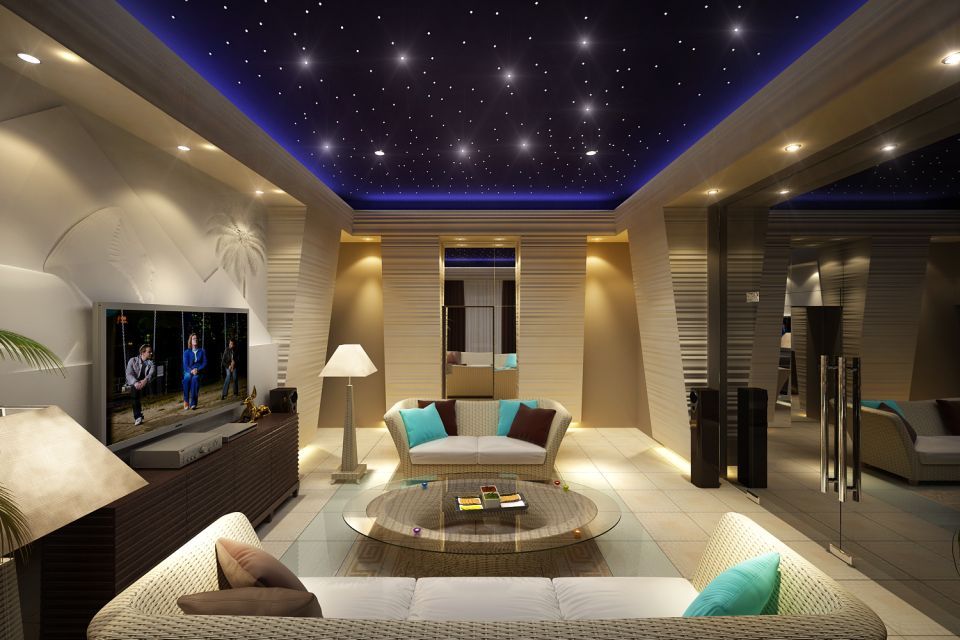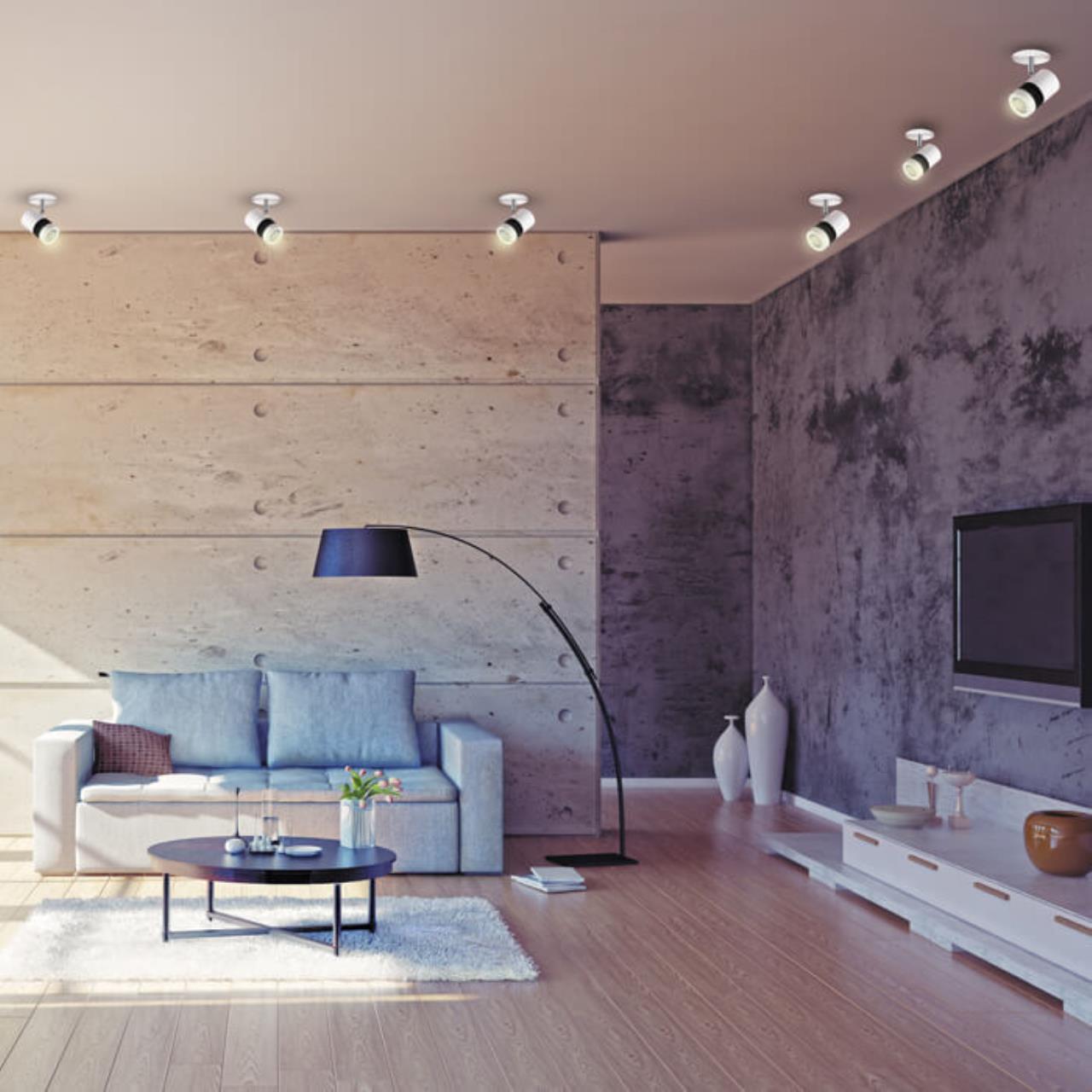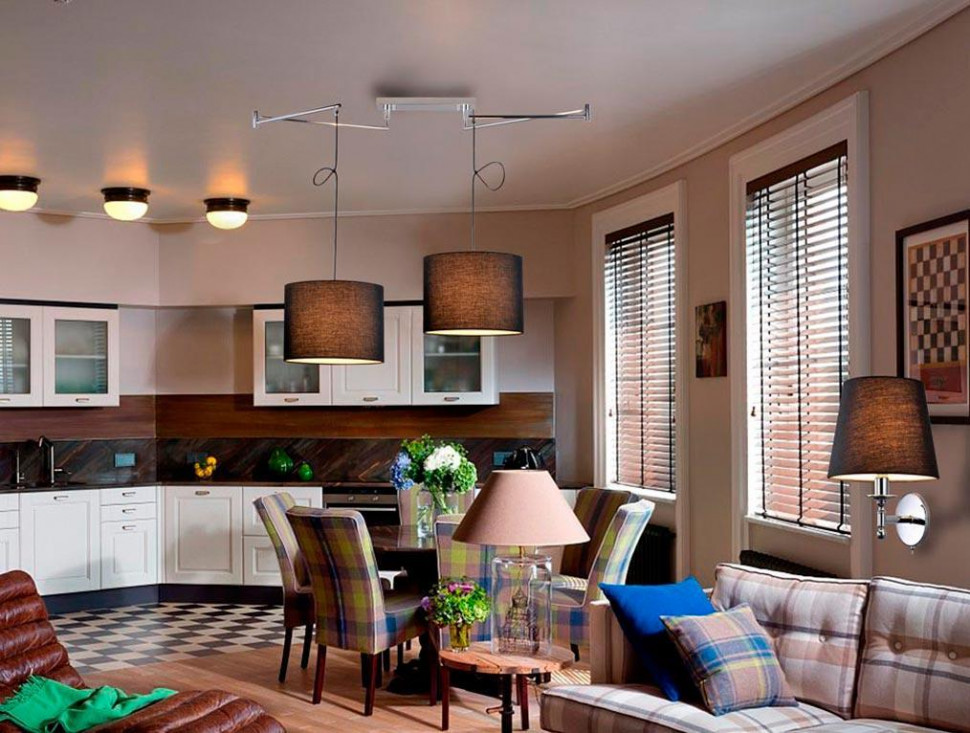Content:
-
How many lamps should be indoors?
-
-
Simple formula
-
-
At what distance to place the lighting elements
-
Selection of lamps for stretch paintings
-
-
Point lighting
-
Chandeliers and plafones
-
Rasteral lighting devices
-
Track systems
-
LED ribbons
-
-
According to what scheme to distribute lighting devices
-
-
With a chandelier
-
With suspended lamps
-
Without a source of central light
-
-
Light design of rooms depending on their functionality
-
-
For the living room
-
For the kitchen
-
For the bedroom
-
For the bathroom
-
For the nursery
-
For the hallway
-

Modern light design: examples in the interior
How many lamps should be indoors?
Before thinking about the location of light sources, you need to think over their number, and for this to take into account a number of nuances:
- The presence of reflective surfaces – if there are many of them, then less lamps will be required.
- It is also important to choose the type of lamps, which depends not only on personal preferences, but also on the type of ceiling structure.
- After that, you can contact the table of lighting standards for different rooms.
Data in the proposed table is given in luxury – units of light measurement:
- kitchen – 150;
- Children’s – 200;
- Corridor and bathroom – 50;
- office – 300;
- Wardrobe – 75.
It is possible to calculate the lighting rate more accurately. There are several useful Internet resources for this.
Simple formula
Calculations can be carried out using various formulas. The simplest of them involves the calculation of the optimal brightness of the lighting, determined in lumens. She looks like this:
X = a*b*c
And in this formula it corresponds to the norm of illumination taking into account the purpose of the room (kitchen, living room, corridor, etc.), B – its square and C – the coefficient of the ceiling height. To calculate the indicator C, you need to measure the height of the ceiling:
- 1 – less than 2.7;
- 1.5 – from 2.7 to 3.5;
- 2 – for higher ceilings.
After calculating the right brightness, it is determined how many lamps should be in a particular room. The value is divided into lamp power, the type of which must be pre -selected.

Power of different types of lamps
At what distance to place the lighting elements
This characteristic is determined by the chosen scheme, but there is a minimum value on which they must be removed – from 30 to 40 cm. In some cases, it can be reduced to 20 cm.
The result may be adjusted. If it is planned to install sconces or floor lamps in the room, then feel free to reduce the norm of lamps, and in the presence of mirror coatings in the room, the distance between the points of light is permissible to increase.
Advice! Determining the intervals between light sources, you should pay attention to the type of ceiling structure. There are ceilings that cannot be overloaded with a large number of lighting elements.
Selection of lamps for stretch paintings
Nowadays, stretch fabrics have gained immense popularity. They look spectacular and amaze the imagination with a variety of shapes, colors and textures, in addition, this type of ceiling structures is quite affordable to the owner of any apartment or house. It is worth recalling that they are mounted simultaneously with the lighting system, so all the lamps must be purchased by the day of installation of the ceiling.
Another important nuance concerns film ceilings. PVC can melt at a temperature of more than 60 degrees, so not all types of lamps are suitable for them. Make sure that the lamps of the selected type of fastening are suitable for installation in a stretch ceiling made of polyvinyl chloride.
It is possible to calculate the lighting rate more accurately. There are several useful Internet resources for this.
Point lighting
They are buried in the ceiling structure, or a little go beyond the surface. Such lighting helps to realize unusual design projects that allow the room to transform beyond recognition.
Point lighting has different types that differ in the method of fastening. For example, built -in models are equipped with springs, overheads are equipped with adjustable racks.

Party lamps in the interior
Chandeliers and plafones
As mentioned above, when installing lighting a stretch ceiling, it is necessary to take into account the permissible power of the lamps. In addition, the choice of chandeliers that can be used. Small models can be suitable for stretch structures. In this case, it is recommended to purchase varieties with lamps that direct the light down. This will not only prevent excessive heating of the ceiling, but also protects from the appearance of glare.
Important! The lamp itself should be lower than the ceiling level by 10 cm.
A hook is needed for chandeliers and plafones, it must be mounted in advance on the ceiling in advance. A cable holding the lamp will be fixed on it. At the end of the installation, the mount will be hidden inside the ceiling.
Rasteral lighting devices
They are a set of fluorescent lamps hidden in a reflective structure, for fastening a few holes are enough. Large rooms are undoubtedly won when choosing this model, since they are quite bright. The disadvantage of them can be called the monotony of forms.
Track systems
The tire allows you to move the lamps at its discretion and unfold them at the right angle. This allows you to highlight individual objects or decorative elements on the walls. They differ in safety and are a successful solution for small rooms. To fix them on a stretch ceiling allow special built -in elements.
LED ribbons
Used as an additional light source. Due to this device, patterns and abstractions are created on the ceiling. The plus of such illumination is obvious – it does not heat up, which means it is absolutely safe, moreover, it is easily attached directly to the canvas. Today, LED ribbons are presented in wide assortments and allow you to make a choice not only in length or width, but also in the color of the products.

LED ceiling lighting
According to what scheme to distribute lighting devices
Whatever scheme you prefer for the ceiling, the extreme light source should be at least 20 cm from the ceiling edge. In the case of stretch ceilings, the distance is reduced to 15 cm. We give examples of popular schemes for placing light sources.
With a chandelier
The dominant role is given to the chandelier and have it in the center of the ceiling. Sands are used as secondary light sources. Such spotlights can be arranged in different ways, including the following methods.
- In the corners. This method will evenly distribute the light in a small room, for example, in the bedroom.
- Around the chandelier. Point lighting, framing the central light source, will add spaciousness.
- By arc or oval. The rectangular room will look advantageous if you apply such a scheme to it. In the case of large rooms, additional spots in the corners will not interfere.
With a suspended lamp
The ceiling light design, on which the central lighting function performs a suspended lamp, can be built similarly to the option with a chandelier.
Without a source of central light
Point lamps are quite acceptable to use as the only element of ceiling lighting. In this case, you can not adhere to a clear scheme or choose one of the finished solutions.
Advice! It is better to combate lighting elements so that the brightness level of each part of the room is regulated independently.
Light design of rooms depending on their functionality
When planning lighting, it is worth considering what functions the room performs. For example, in the kitchen, the illumination of the working area is especially important, and in the corridor it is necessary to create a bright light near the mirror. Given these and other features, standard lamps are adjusted. Check out the tips on the light design of various rooms.
For the living room
It is difficult to imagine a hall without a chandelier, because he usually has the largest quadrature. If it does not arise with its placement – it is usually in the center, then how to place spotlights? Experts recommend either to let them around the entire perimeter, or distribute them in the corners, or mount on curly elements in the presence of a multi -tiered structure.
Small living rooms are not found so often, but if this is just your case, then use track systems or overhead devices along the edges of the ceiling.

Chandelier and spotlights for lighting the living room
Advice! A corner for relaxation will only win if several spots are located over it. Soft lighting will create a relaxing atmosphere in this part of the room.
For the kitchen
The two main zones of this room are dining and working. Each of them provides for its own lighting mode. So, in the first there is enough pair-three spots or modern lamps on cables, they are placed above the table or persistent. The second requires a more powerful backlight so that lighting devices follow each other every 30 cm and make the cooking process as comfortable as possible.
For the bedroom
Light here carries the function of creating a pleasant atmosphere, and also helps to put accents on certain interior items.
Putting spots in the line will be quite appropriate, for example, along the bed and along the other wall located opposite the bed. If this is not enough, then in the middle of the ceiling a source of central light is added.
For the bathroom
The brightest accent of the room is a bath or cabin. They are lit by two or three lighting devices. Another important zone that requires active backlight is a mirror. In a square bathroom, it is good to place spots in every corner.
For the nursery
The most intense lighting is required by the game part and the working area, and in the place for sleeping the baby a fairly weak ceiling lighting, setting up for a relaxing vacation.
If the ceiling has several levels, then the spots for each zone will successfully stand on separate tiers of the structure, and on the ceiling itself the backlight is distributed in the form of circles or rows.
For the hallway
When choosing a lighting scheme, it is worth starting from its shape. A very popular option involves the installation of sofitis or other light elements in a row. The specified scheme can visually lengthen the wide hallway and no less harmoniously fits into the room of rectangular shape.

Spotlights in one row in the hallway
Properly planned lighting is an important point in the design of any dwelling. It allows you to create comfortable conditions for the owners of the apartment and create a unique interior. If questions arise when planning a lighting system, you should seek advice to designers who will tell the best option for your home.
